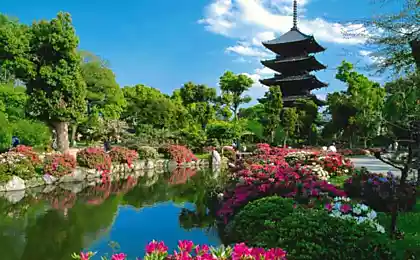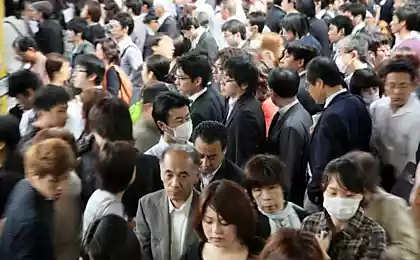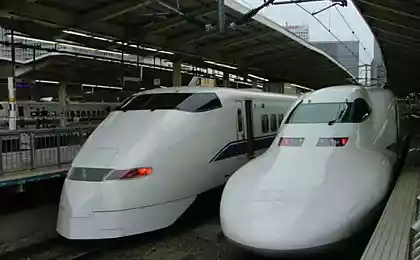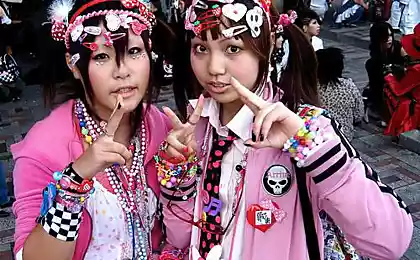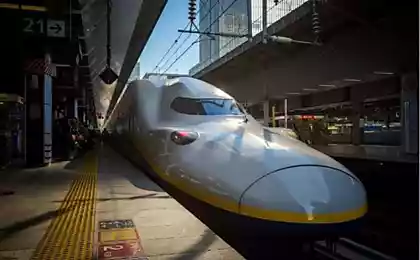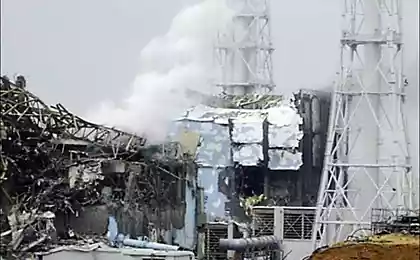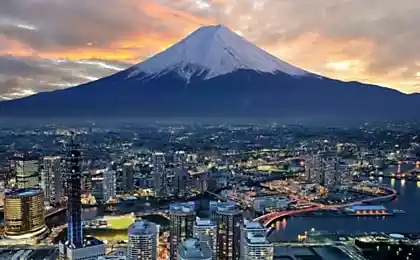1738
Jubilee symbol of the new Japan
Almost 50 years ago, in October 1964 in Japan, was launched the world's first high-speed train "Shinkansen" (aka bullet-train), capable of speeds up to 210 km / h and for all who became a symbol of the "new" Japan and its growing economic power. First line to connect two major Japanese cities - Tokyo and Osaka, reducing the minimum travel time between them with 7, 5 to 4 hours.
27 photo.
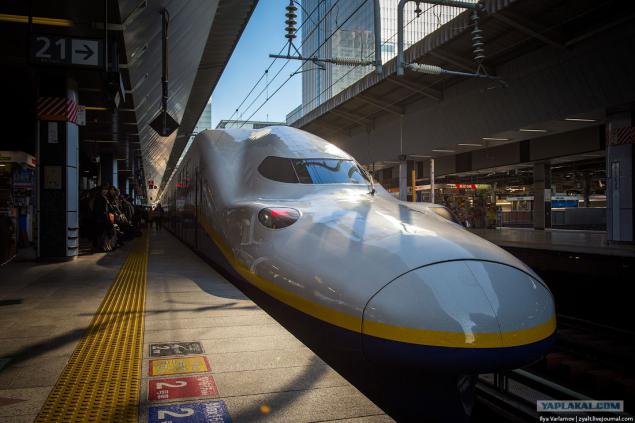
Literally translated from the Japanese word "Shinkansen" means "new line". Before the advent of high-speed trains in Japan Railways were narrow gauge (1,067 mm), and had a lot of bends due to the peculiarities of the local topography. On such roads to develop high speed was too limited. For the "Shinkansen" were specifically designed new line has a standard gauge in 1435 mm.
Why Japan initially deviated from the international standard is still not fully understood. It is believed that it was the decision of a certain Mr. Okubo, who was the person in charge at the time of commencement of construction of the first railway in Japan. Of course, the narrow gauge is cheaper, and the trains themselves were smaller and more economical to manufacture. However, along with this it also means less load capacity and low speed. Therefore, the appropriateness of this decision for the Japanese remains a big question. In the early 20th century, the proposed project for the restructuring paintings by international standards, and although supporting this idea was a lot, but instead it was decided to spend the money on building new directions. Thus, the narrow gauge spread throughout Japan that still delivers a lot of inconvenience.

Supporters of the broad gauge was able to realize their projects in the life of the railroad, laid by the Japanese in the early 30-ies. colonized in South Manchuria. In 1934, between the cities of Dalian and Changchun (700 km) was launched on the legendary "Asia Express", revealing the character of the Japanese imperial power of the time. Capable of speeds over 130 km / h, it is far superior to the railway system in China at that time, and was even much faster than the fastest express train in Japan. Yes, and on a global scale "Asia Express" was an impressive performance. For example, the world's first air-conditioned cars were equipped with it in it. Restaurant car was equipped with a fridge, also had a special car - a viewing platform with windows around the perimeter, furnished with leather chairs and bookshelves. Probably, this example was the final argument in favor of the broad gauge, and gave rise to the first high-speed railway projects in Japan. In 1940, the Japanese government approved the incredible scale project. Even then, the project involved the creation of a train capable of speeds up to 200 km / h, but the Japanese government is not going to be limited to laying lines only in Japan. It was supposed to pave the underwater tunnel to the Korean Peninsula and stretch as much as the way to Beijing. Construction has already partially started, but soon began the war and the subsequent deterioration of the military and political position of Japan ended the imperial ambitions. In 1943, the project had been discontinued, the same year was the last for the "Asia Express". Nevertheless, some areas of the lines of "Shinkansen" operated today were built in the pre-war years.
On the construction of "Shinkansen" again talking 10 years after the war. Rapid economic growth has created a large demand for freight and passenger traffic in the country. However, the idea to revive the project were completely unpopular and was heavily criticized. At that time, it was strongly believed that road and air transport displace rail soon as it happened, for example, in the US and some European countries. The project was again in jeopardy.
In 1958, between Tokyo and Osaka, as yet narrow gauge, was launched on a direct ancestor "Shinkansen" - Business Express "Kodama". With a maximum speed of 110 km / h, he covered the distance between cities in 6, 5 hours, making it possible day trips. In Japan, where the culture of doing business based on personal meetings, it was a very convenient solution. Nevertheless, he served for a brief period. The incredible popularity of "Kodama" did not leave any doubt in the need for high-speed lines, and less than a year the government finally approved the construction project "Shinkansen".
Business Express "Kodama", 1958-1964 gg.
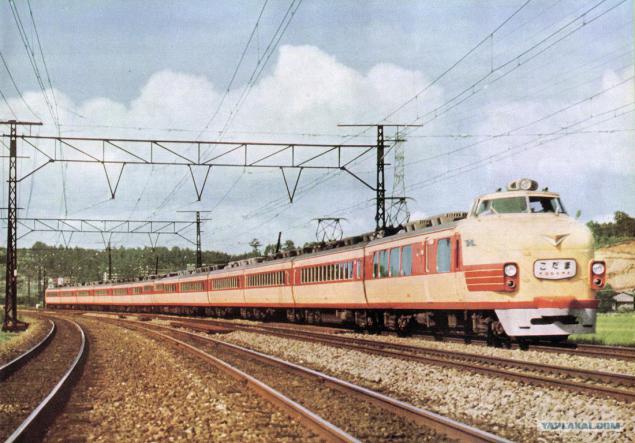
It is widely believed that the launch of the "Shinkansen" was scheduled for the opening of the Olympic Games in Tokyo, but the Japanese deny it. Construction lines "Shinkansen" began in March 1959, more than a month before Tokyo was chosen host city for the games. However, the Olympics came in very handy. Originally announced budget for the construction of "Shinkansen" was obviously too small and everyone knew it, but to claim the actual numbers were too risky. Credit allocated by the World Bank under a fairly low percentage, and did not cover half the cost. The real value of which, in the end, exceed the stated almost 2, 5 times failed to cover, "having obtained" money from the state, ostensibly to catch the opening of the Olympics!
Early morning 1 October 1964 at Tokyo Station ceremony of the first run "Shinkansen" with a specially constructed platform number 19. Platform magnificently decorated red and white ribbons and traditional Japanese paper ball "Kusudama". Tronuvshegosya train ripped the tape, the ball opened and out of the will of white doves fluttered 50. Then there was music, fireworks and general jubilation of thousands of Japanese, do not be lazy to visit at 5 am so momentous event. The same evening photos "Shinkansen" appeared on the front pages of all the major publications of the country under the loud headlines, broadcasts about the beginning of a new era in the history of Japan, and, what could be modest, around the world.
Launching ceremony of the first "Shinkansen". Tokyo, 1964.

A sense of national pride for the "Shinkansen" not sidestep any of the Japanese, and the emperor himself, saying he wrote about whether a song or whether ode.
In 1975, Japan visited the queen of the country-the homeland of the railway. It is, of course, about England. The royal couple arrived on a friendly visit to the Emperor, and one of the first items in the program of entertainment was a trip to the "miracle train" to Kyoto. For Japan, it was the perfect occasion to show off, but a rare chance and could not miss the quirky Japanese unions. Almost immediately upon arrival of the Queen workers staged the first in the history of Japanese railway strike. In short, all drivers "Shinkansen", of which there were 1,100 people, refused to roll queen, until you have made the union's demands. Naturally, cornered bosses demands quickly complied, but the ride on the "Sinkansene" Queen succeeded only been on the way back. Series of setbacks did not end. On the day when the queen was to take the train, go heavy downpour and the train was late by as much as 2 minutes. In general, if it will work to make an impression on Elizabeth II or not - is unknown, but it is said to strike it was not offended, and took everything with humor. She said she herself is no stranger to strikes.
Train "Shinkansen", painted with paint in protest.

Contrary to expectations, the skeptical, "Shinkansen" was incredibly successful and fast enough to recoup the costs of construction. Total 8 years was opened a second line. Already by 1981 the debt by the World Bank loan was completely covered. Moreover, today the "Shinkansen" provides up to 80% profit Japan Railways. At the moment there are 8 lines "Shinkansen" total length of almost 3000 km and they continue to be built.
The circuit lines "Shinkansen"
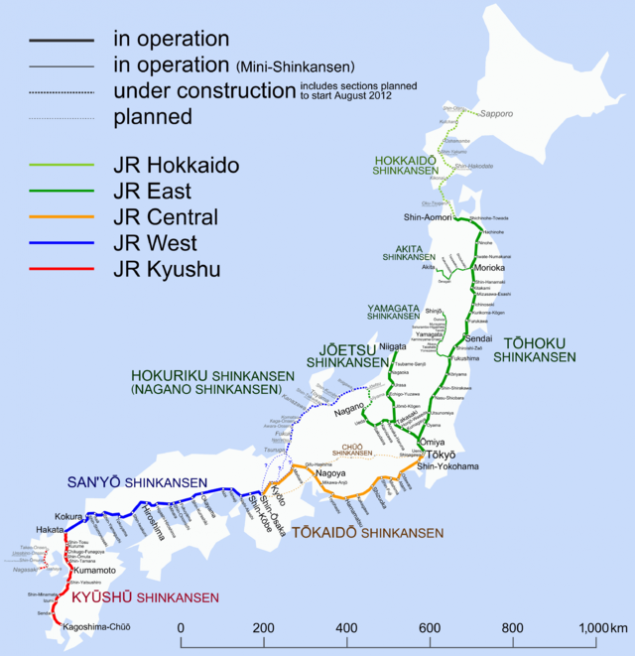
Of course, in the 50 years of its existence, "Shinkansen" was rather big evolutionary path, though not always cloudless.
In the 80-ies. 575 inhabitants of the city of Nagoya, whose houses were located along the paths, are suing the management of "Shinkansen" complaining about the noise and strong vibrations. Immediately after this technology have been introduced to reduce noise and vibration, improving the quality of railway track. It has also introduced rules slow down when passing through densely populated areas.
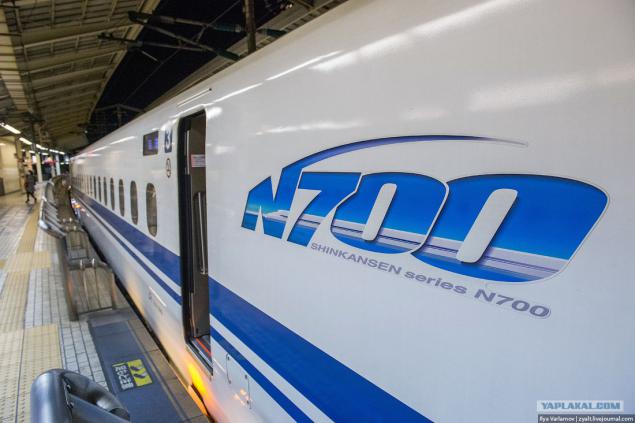
Today, the "Shinkansen" virtually silent, the path often held in the vicinity of buildings without causing much discomfort. Another step in the development of technology began in the field of energy conservation. And all because of Japan in which 99, 7% of oil imported (not from Russia), appears to be very sensitive to the repeated oil shocks. Thus, under the pressure of both external and internal factors in the person sverhtrebovatelnyh Japanese "Shinkansen" rapidly improved. Nevertheless, the very first model train was permanent until 1982, and even after the emergence of new models remained in service right up to 2008
In 1987, the Japanese National Railways was privatized, instead of the state monopoly 5 new independent companies. Healthy competition has given a new impetus to the development of technology and quality of service.
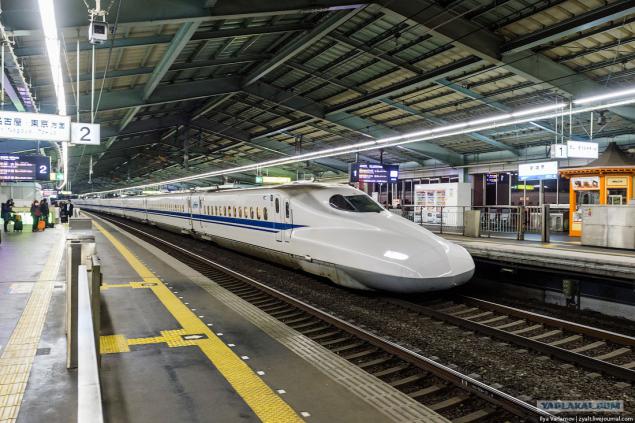
The trains have appeared so-called "green cars", comparable with the level of business class on airplanes. Actually, the airline and were and are still the main competitors "Shinkansen". These cars have become svoebraznym indicator of the economic situation in the country. During the heyday of many companies buy their employees to travel to the place of "green cars", but with the decline of the economy are usually empty.
Now the interior of the car looks like this:
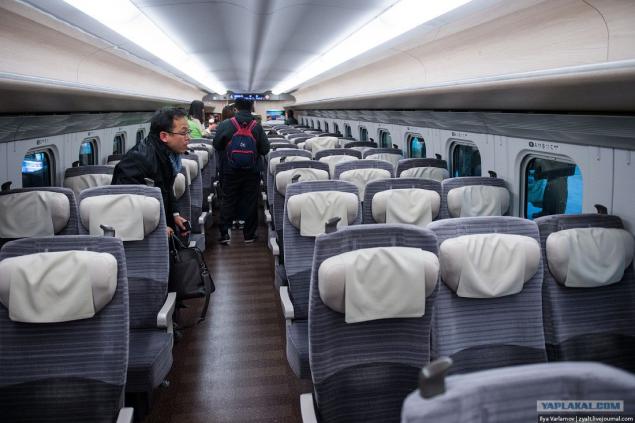
Tickets are available with and without spot. In cars without seat may have to sit in the middle,, but cheaper;)

Toilet:
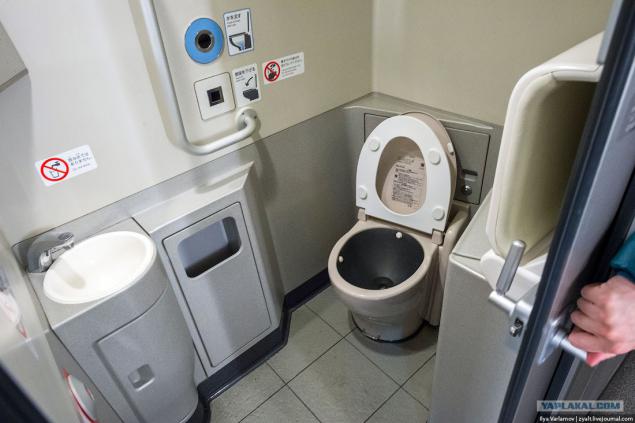
At the station, the train hangs scheme, so that immediately clear what car you need:
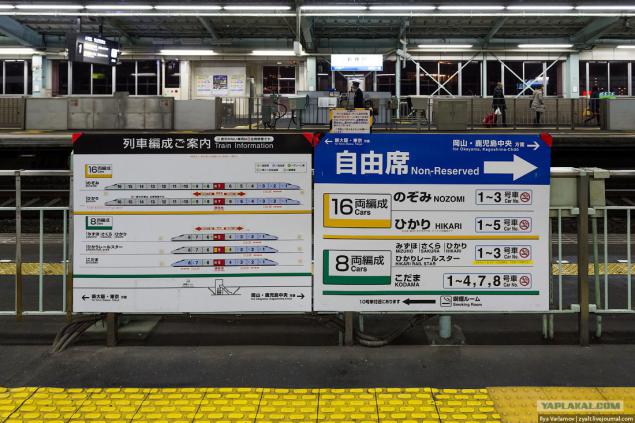
On landing all stand in neat lines. On the platform drawn lines for the queues in each car.
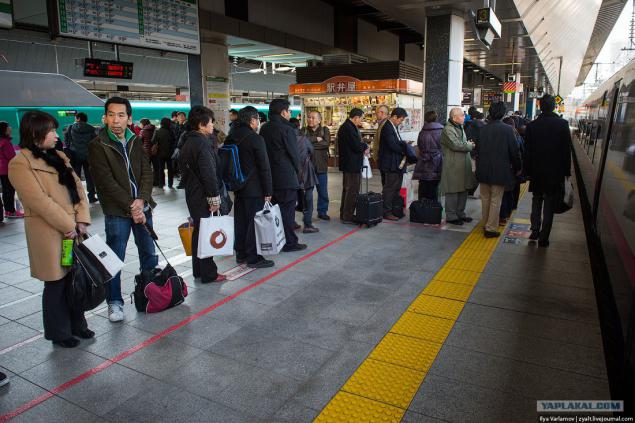
...

27 photo.

Literally translated from the Japanese word "Shinkansen" means "new line". Before the advent of high-speed trains in Japan Railways were narrow gauge (1,067 mm), and had a lot of bends due to the peculiarities of the local topography. On such roads to develop high speed was too limited. For the "Shinkansen" were specifically designed new line has a standard gauge in 1435 mm.
Why Japan initially deviated from the international standard is still not fully understood. It is believed that it was the decision of a certain Mr. Okubo, who was the person in charge at the time of commencement of construction of the first railway in Japan. Of course, the narrow gauge is cheaper, and the trains themselves were smaller and more economical to manufacture. However, along with this it also means less load capacity and low speed. Therefore, the appropriateness of this decision for the Japanese remains a big question. In the early 20th century, the proposed project for the restructuring paintings by international standards, and although supporting this idea was a lot, but instead it was decided to spend the money on building new directions. Thus, the narrow gauge spread throughout Japan that still delivers a lot of inconvenience.

Supporters of the broad gauge was able to realize their projects in the life of the railroad, laid by the Japanese in the early 30-ies. colonized in South Manchuria. In 1934, between the cities of Dalian and Changchun (700 km) was launched on the legendary "Asia Express", revealing the character of the Japanese imperial power of the time. Capable of speeds over 130 km / h, it is far superior to the railway system in China at that time, and was even much faster than the fastest express train in Japan. Yes, and on a global scale "Asia Express" was an impressive performance. For example, the world's first air-conditioned cars were equipped with it in it. Restaurant car was equipped with a fridge, also had a special car - a viewing platform with windows around the perimeter, furnished with leather chairs and bookshelves. Probably, this example was the final argument in favor of the broad gauge, and gave rise to the first high-speed railway projects in Japan. In 1940, the Japanese government approved the incredible scale project. Even then, the project involved the creation of a train capable of speeds up to 200 km / h, but the Japanese government is not going to be limited to laying lines only in Japan. It was supposed to pave the underwater tunnel to the Korean Peninsula and stretch as much as the way to Beijing. Construction has already partially started, but soon began the war and the subsequent deterioration of the military and political position of Japan ended the imperial ambitions. In 1943, the project had been discontinued, the same year was the last for the "Asia Express". Nevertheless, some areas of the lines of "Shinkansen" operated today were built in the pre-war years.
On the construction of "Shinkansen" again talking 10 years after the war. Rapid economic growth has created a large demand for freight and passenger traffic in the country. However, the idea to revive the project were completely unpopular and was heavily criticized. At that time, it was strongly believed that road and air transport displace rail soon as it happened, for example, in the US and some European countries. The project was again in jeopardy.
In 1958, between Tokyo and Osaka, as yet narrow gauge, was launched on a direct ancestor "Shinkansen" - Business Express "Kodama". With a maximum speed of 110 km / h, he covered the distance between cities in 6, 5 hours, making it possible day trips. In Japan, where the culture of doing business based on personal meetings, it was a very convenient solution. Nevertheless, he served for a brief period. The incredible popularity of "Kodama" did not leave any doubt in the need for high-speed lines, and less than a year the government finally approved the construction project "Shinkansen".
Business Express "Kodama", 1958-1964 gg.

It is widely believed that the launch of the "Shinkansen" was scheduled for the opening of the Olympic Games in Tokyo, but the Japanese deny it. Construction lines "Shinkansen" began in March 1959, more than a month before Tokyo was chosen host city for the games. However, the Olympics came in very handy. Originally announced budget for the construction of "Shinkansen" was obviously too small and everyone knew it, but to claim the actual numbers were too risky. Credit allocated by the World Bank under a fairly low percentage, and did not cover half the cost. The real value of which, in the end, exceed the stated almost 2, 5 times failed to cover, "having obtained" money from the state, ostensibly to catch the opening of the Olympics!
Early morning 1 October 1964 at Tokyo Station ceremony of the first run "Shinkansen" with a specially constructed platform number 19. Platform magnificently decorated red and white ribbons and traditional Japanese paper ball "Kusudama". Tronuvshegosya train ripped the tape, the ball opened and out of the will of white doves fluttered 50. Then there was music, fireworks and general jubilation of thousands of Japanese, do not be lazy to visit at 5 am so momentous event. The same evening photos "Shinkansen" appeared on the front pages of all the major publications of the country under the loud headlines, broadcasts about the beginning of a new era in the history of Japan, and, what could be modest, around the world.
Launching ceremony of the first "Shinkansen". Tokyo, 1964.

A sense of national pride for the "Shinkansen" not sidestep any of the Japanese, and the emperor himself, saying he wrote about whether a song or whether ode.
In 1975, Japan visited the queen of the country-the homeland of the railway. It is, of course, about England. The royal couple arrived on a friendly visit to the Emperor, and one of the first items in the program of entertainment was a trip to the "miracle train" to Kyoto. For Japan, it was the perfect occasion to show off, but a rare chance and could not miss the quirky Japanese unions. Almost immediately upon arrival of the Queen workers staged the first in the history of Japanese railway strike. In short, all drivers "Shinkansen", of which there were 1,100 people, refused to roll queen, until you have made the union's demands. Naturally, cornered bosses demands quickly complied, but the ride on the "Sinkansene" Queen succeeded only been on the way back. Series of setbacks did not end. On the day when the queen was to take the train, go heavy downpour and the train was late by as much as 2 minutes. In general, if it will work to make an impression on Elizabeth II or not - is unknown, but it is said to strike it was not offended, and took everything with humor. She said she herself is no stranger to strikes.
Train "Shinkansen", painted with paint in protest.

Contrary to expectations, the skeptical, "Shinkansen" was incredibly successful and fast enough to recoup the costs of construction. Total 8 years was opened a second line. Already by 1981 the debt by the World Bank loan was completely covered. Moreover, today the "Shinkansen" provides up to 80% profit Japan Railways. At the moment there are 8 lines "Shinkansen" total length of almost 3000 km and they continue to be built.
The circuit lines "Shinkansen"

Of course, in the 50 years of its existence, "Shinkansen" was rather big evolutionary path, though not always cloudless.
In the 80-ies. 575 inhabitants of the city of Nagoya, whose houses were located along the paths, are suing the management of "Shinkansen" complaining about the noise and strong vibrations. Immediately after this technology have been introduced to reduce noise and vibration, improving the quality of railway track. It has also introduced rules slow down when passing through densely populated areas.

Today, the "Shinkansen" virtually silent, the path often held in the vicinity of buildings without causing much discomfort. Another step in the development of technology began in the field of energy conservation. And all because of Japan in which 99, 7% of oil imported (not from Russia), appears to be very sensitive to the repeated oil shocks. Thus, under the pressure of both external and internal factors in the person sverhtrebovatelnyh Japanese "Shinkansen" rapidly improved. Nevertheless, the very first model train was permanent until 1982, and even after the emergence of new models remained in service right up to 2008
In 1987, the Japanese National Railways was privatized, instead of the state monopoly 5 new independent companies. Healthy competition has given a new impetus to the development of technology and quality of service.

The trains have appeared so-called "green cars", comparable with the level of business class on airplanes. Actually, the airline and were and are still the main competitors "Shinkansen". These cars have become svoebraznym indicator of the economic situation in the country. During the heyday of many companies buy their employees to travel to the place of "green cars", but with the decline of the economy are usually empty.
Now the interior of the car looks like this:

Tickets are available with and without spot. In cars without seat may have to sit in the middle,, but cheaper;)

Toilet:

At the station, the train hangs scheme, so that immediately clear what car you need:

On landing all stand in neat lines. On the platform drawn lines for the queues in each car.

...


